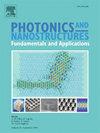具有GeTe相变平面结构的可重构窄带到宽带吸收器
IF 2.9
3区 物理与天体物理
Q3 MATERIALS SCIENCE, MULTIDISCIPLINARY
Photonics and Nanostructures-Fundamentals and Applications
Pub Date : 2025-09-01
DOI:10.1016/j.photonics.2025.101447
引用次数: 0
摘要
像GeTe这样的相变材料(PCMs)在可重构的纳米光子器件中已经变得必不可少,因为它们能够在非晶和晶体状态之间经历可逆的结构转变,从而导致光学性质的显著可调变化。这种可调节性允许对光-物质相互作用进行动态控制,使pcm成为光开关,调制器和自适应光子系统的理想选择。在这项研究中,我们提出了一种基于平面GeTe结构的可重构窄带到宽带吸收器,该结构集成了GaAs层和硅、金薄膜衬底,并通过有限元方法对其进行了设计和数值分析。我们的设计利用了GeTe的不同行为:非晶相可以窄带吸收,而晶体相可以拓宽吸收光谱,覆盖1150到1750 nm的范围。还评估了材料厚度的影响,以评估制造误差容差,从而可以更精确地选择所需的配置。分析了斜入射角对横向电(TE)和横向磁(TM)极化波的影响。此外,还研究了场耦合的物理机制。本文章由计算机程序翻译,如有差异,请以英文原文为准。
Reconfigurable narrowband-to-broadband absorber featuring GeTe’s phase change planar structures
Phase change materials (PCMs) like GeTe have become essential in reconfigurable nanophotonic devices due to their ability to undergo reversible structural transitions between amorphous and crystalline states, which lead to significant, tunable changes in optical properties. This tunability allows for dynamic control over light-matter interactions, making PCMs ideal for optical switches, modulators, and adaptive photonic systems. In this study, we propose a reconfigurable narrowband-to-broadband absorber based on planar GeTe structures integrated with GaAs layers and a Silicon and a gold thin-film substrate, which we designed and analyzed numerically by the Finite Element Method (FEM). Our design leverages the contrasting behaviors of GeTe: the amorphous phase enables narrowband absorption, while the crystalline phase broadens the absorption spectrum to cover the range from 1150 to 1750 nm. The influence of material thickness was also assessed to evaluate manufacturing error tolerances, allowing for a more precise selection of the desired configuration. The effects of oblique incidence angles on Transversal Electric (TE) and Transversal Magnetic (TM) polarized waves were analyzed for both cases. Additionally, the physical mechanisms of field coupling were investigated.
求助全文
通过发布文献求助,成功后即可免费获取论文全文。
去求助
来源期刊
CiteScore
5.00
自引率
3.70%
发文量
77
审稿时长
62 days
期刊介绍:
This journal establishes a dedicated channel for physicists, material scientists, chemists, engineers and computer scientists who are interested in photonics and nanostructures, and especially in research related to photonic crystals, photonic band gaps and metamaterials. The Journal sheds light on the latest developments in this growing field of science that will see the emergence of faster telecommunications and ultimately computers that use light instead of electrons to connect components.

 求助内容:
求助内容: 应助结果提醒方式:
应助结果提醒方式:


